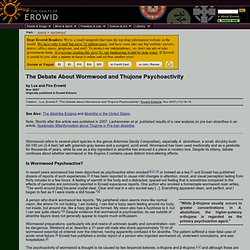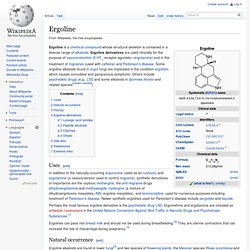

Wormwood Vaults : The Debate About Wormwood and Thujone Psychoactivity. See Also: The Absinthe Enigma and Absinthe in the United States.

Note: Shortly after this article was published in 2007, Lachenmeier et al. published results of a new analysis on pre-ban absinthes in an article, Systematic Misinformation about Thujone in Pre-ban Absinthe. Wormwood refers to several plant species in the genus Artemisia (family Compositae), especially A. absinthium, a small, shrubby bush 50-100 cm (2-4 feet) tall with greenish-gray leaves and a pungent, acrid smell. Wormwood has been used medicinally and as a pesticide for thousands of years, while its use as a key ingredient in absinthe has ensured it a place in modern lore. Despite its infamy, debate continues about whether wormwood or the thujone it contains cause distinct mind-altering effects.
Is Wormwood Psychoactive? "While β-thujone usually occurs in greater concentrations in A. absinthium, the higher-potency α-thujone is regarded as the primary psychoactive agent. " Thujone's Biological Mechanisms. - Index page. 7 Psychoactive Substances to Expand Your Mind. Erowid. Erowid Reference 8511 : Here Today, Gone Tomorrow...and Back Again? A Review of Herbal Marijuana Alternatives (K2, Spice), Synthetic Cathinones (Bath Salts), Kratom, Salvia divinorum, Methoxetamine, and Piperazines : Rosenbaum CD, Carreiro SP, Babu KM. Psychonaut Community.
Entheogenesis, Shamanism, and Psychonautics. Psychopharmacological studies on (-)-nuciferine and its Hofmann degradation product atherosperminine. Calea zacatechichi Vault. MDMA (Ecstasy) Ergoline. Ergoline is a chemical compound whose structural skeleton is contained in a diverse range of alkaloids.

Ergoline derivatives are used clinically for the purpose of vasoconstriction (5-HT1 receptor agonists—ergotamine) and in the treatment of migraines (used with caffeine) and Parkinson's disease. Some ergoline alkaloids found in ergot fungi are implicated in the condition ergotism, which causes convulsive and gangrenous symptoms. Others include psychedelic drugs (e.g., LSD and some alkaloids in Ipomoea tricolor and related species[citation needed]). Uses[edit] In addition to the naturally occurring ergonovine (used as an oxytocic) and ergotamine (a vasoconstrictor used to control migraine), synthetic derivatives of importance are the oxytocic methergine, the anti-migraine drugs dihydroergotamine and methysergide, hydergine (a mixture of dihydroergotoxine mesylates, INN: ergoline mesylates), and bromocriptine, used for numerous purposes including treatment of Parkinson's disease.
Doxylamine. Doxylamine is a first generation antihistamine.

It can be used by itself as a short-term sedative and in combination with other drugs to provide night-time allergy and cold relief. Doxylamine is also used in combination with the analgesics paracetamol (acetaminophen) and codeine as an analgesic/calmative preparation, and is prescribed in combination with vitamin B6 (pyridoxine) to prevent morning sickness in pregnant women. Its foetal safety is "A" in Briggs' Reference Guide to Foetal and Neonatal Risk.[3] Indications[edit] Doxylamine is a member of the ethanolamine class of antihistamines and has anti-allergy power superior to almost every other antihistamine on the market, with the exception of diphenhydramine (Benadryl); it is also the most effective over-the-counter sedative available in the United States and is more sedating than some prescription hypnotics.[4] One study found that doxylamine succinate was more effective than the barbiturate phenobarbital for use as a sedative.[4]
Ergometrine. It is on the World Health Organization's List of Essential Medicines, a list of the most important medications needed in a basic health system.[1] Medical use[edit] It has a medical use in obstetrics to facilitate delivery of the placenta and to prevent bleeding after childbirth by causing smooth muscle tissue in the blood vessel walls to narrow, thereby reducing blood flow. It is usually combined with oxytocin (Syntocinon) as syntometrine. It can induce spasm of the coronary arteries.[2] It is used to diagnose Variant (Prinzmetal's) angina.[3] Side effects[edit] Mechanism of action[edit] While it acts at alpha-adrenergic, dopaminergic, and serotonin receptors (the 5-HT2 receptor), it exerts on the uterus (and other smooth muscles) a powerful stimulant effect not clearly associated with a specific receptor type. LSA CREATION.